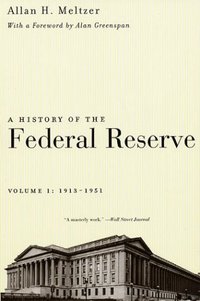

Purchase
A History Of The Federal Reserve, Volume 1: 1913-1951
Allan H. Meltzer
University Of Chicago Press
June 2004
On Sale: June 1, 2004
808 pages
ISBN: 0226520005
EAN: 9780226520001
Paperback
Add to Wish List
Non-Fiction
Allan H. Meltzer's monumental history of the Federal Reserve
System tells the story of one of America's most influential
but least understood public institutions. This first volume
covers the period from the Federal Reserve's founding in
1913 through the Treasury-Federal Reserve Accord of 1951,
which marked the beginning of a larger and greatly changed
institution. To understand why the Federal Reserve acted as it did at key
points in its history, Meltzer draws on meeting minutes,
correspondence, and other internal documents (many made
public only during the 1970s) to trace the reasoning behind
its policy decisions. He explains, for instance, why the
Federal Reserve remained passive throughout most of the
economic decline that led to the Great Depression, and how
the Board's actions helped to produce the deep recession of
1937 and 1938. He also highlights the impact on the
institution of individuals such as Benjamin Strong, governor
of the Federal Reserve Bank of New York in the 1920s, who
played a key role in the adoption of a more active monetary
policy by the Federal Reserve. Meltzer also examines the
influence the Federal Reserve has had on international
affairs, from attempts to build a new international
financial system in the 1920s to the Bretton Woods Agreement
of 1944 that established the International Monetary Fund and
the World Bank, and the failure of the London Economic
Conference of 1933. Written by one of the world's leading economists, this
magisterial biography of the Federal Reserve and the people
who helped shape it will interest economists, central
bankers, historians, political scientists, policymakers, and
anyone seeking a deep understanding of the institution that
controls America's purse strings.
Comments
No comments posted.
Registered users may leave comments.
Log in or register now!
| 


 © 2003-2025 off-the-edge.net
all rights reserved Privacy Policy
© 2003-2025 off-the-edge.net
all rights reserved Privacy Policy